
Introduction
The culinary world is experiencing a revolution, driven by innovation and a desire to reshape dining experiences. This new wave of cuisine pushes traditional boundaries, blending cultures and flavors as never before. Chefs around the globe are embracing technology, sustainability, and creativity to craft dishes that not only please the palate but also spark conversation. From molecular gastronomy to hyper-local ingredients, cutting-edge culinary culture is about breaking norms and redefining what it means to eat. This trend involves not just food but the entire dining experience, from the ambiance to the ethics behind production. As we explore this cultural shift, we'll uncover what it means for future dining experiences.
Global Fusion Cuisine
Global fusion cuisine stands as a pillar of contemporary culinary innovation. By amalgamating elements from diverse cultural cuisines, chefs create unique flavor profiles that captivate diners. Korean tacos, sushi burgers, and Indian pizza exemplify this trend, each an imaginative fusion of traditional dishes. These novel creations often introduce diners to unfamiliar tastes and encourage gastronomic exploration. Renowned chefs like Roy Choi and David Chang have pioneered this movement, drawing inspiration from their diverse backgrounds. Global fusion cuisine reflects a more interconnected world, celebrating the beauty of diverse global flavors on a single plate.
Sustainable and Ethical Dining
As consumer awareness of environmental issues grows, sustainability in dining has taken center stage. Chefs are increasingly focusing on locally sourced ingredients, minimizing food waste, and adopting farm-to-table practices. Ethical dining extends beyond sourcing to include fair labor practices and animal welfare considerations. Notable restaurants, such as Noma, champion this cause by forging strong relationships with local producers. Sustainable dining isn't just beneficial for the planet; it also enriches the dining experience by ensuring ingredients are fresh and vibrant. This trend not only appeals to eco-conscious diners but also shapes the future of the culinary industry.
Molecular Gastronomy
Molecular gastronomy is science meeting the art of cooking, transforming everyday ingredients into unexpected textures and flavors. Through techniques like spherification, gelification, and emulsification, chefs like Heston Blumenthal and Ferran Adrià evoke a sense of magic on the plate. Dishes that smoke, foam, or change colors invite diners into a multi-sensory dining adventure. This scientific approach to cooking embraces both traditional and modern methods, pushing the boundaries of what's possible in the kitchen. Molecular gastronomy, while often seen as high-brow, broadens the landscape for culinary creativity and innovation.
Technology in the Kitchen
The integration of technology in culinary practices has accelerated, enhancing both efficiency and dining aesthetics. 3D food printers, smart kitchen appliances, and AI-assisted cooking systems are making their way into professional kitchens. These advancements allow chefs to experiment with intricate designs and precise cooking techniques. Restaurants leverage technology to personalize dining experiences, such as tailoring dishes to individual dietary preferences using data analytics. As technology evolves, it promises even more groundbreaking changes in how we cultivate and consume food. However, while technology offers innovations, it also emphasizes the importance of retaining the essence of traditional cooking.
Plant-Based and Alternative Proteins
The rise of plant-based dining represents a monumental shift in culinary culture. As more consumers opt for healthier, environmentally friendly diets, chefs are showcasing the versatility of vegetables and plant proteins. Dishes featuring ingredients like jackfruit, lentils, and chickpeas creatively mimic traditional meat textures and flavors. This transition is supported by significant investments in alternative protein innovations, ensuring that plant-based diets are not only sustainable but also delicious. Leading the charge are chefs like Chloe Coscarelli, demonstrating that vegan cuisine can be inventive and satisfying. This movement signifies a fundamental realignment in the culinary world, focusing on health and sustainability.
Zero-Waste Initiatives
The zero-waste movement in the culinary world is centered around repurposing every part of an ingredient, minimizing food waste. Progressive chefs engage in practices like using vegetable stems for broths and crafting desserts from fruit peels. Notably, restaurants like Silo in London are pioneers in this approach, integrating sustainability into their core philosophy. This trend resonates with consumers seeking mindful dining options and reflects broader societal shifts towards environmental consciousness. Zero-waste not only challenges chefs creatively but also aligns with growing consumer demand for ethical dining practices. These innovative strategies are shifting paradigms in kitchens globally.
A Focus on Culinary Storytelling
Incorporating storytelling in dining experiences transforms a meal into a narrative journey. Chefs are increasingly sharing the stories behind their dishes, from the origins of the ingredients to their cultural significance. This enhances diners’ appreciation for the effort and thought behind each dish. Restaurants like Alinea and Blue Hill emphasize this approach, offering interactive dining experiences that engage multiple senses. Culinary storytelling fosters a deeper connection between diners and chefs, cultivating an understanding of the artistic and cultural dimensions of cooking. This trend enriches dining by offering context and meaning to the culinary experience.
Innovative Restaurant Concepts
New restaurant concepts are revolutionizing how we experience food and dining. Pop-ups, supper clubs, and immersive dining experiences are pushing the envelope on how meals are presented. These settings often encourage diners to rethink their relationship with food, inviting them into ever-evolving culinary spaces. Chefs are employing creative restaurant designs, themed dinners, and interactive settings that allow guests to engage with their meals in novel ways. This diversity in dining experiences ensures that restaurants remain dynamic and competitive. Innovative concepts are reshaping consumer expectations, emphasizing experience as much as culinary mastery.
Conclusion
The cutting-edge culinary culture is about more than stylistic trends; it’s a dynamic movement towards embracing creativity and addressing contemporary challenges. From global fusion to zero-waste, these trends reflect an evolving landscape where innovation meets ethics. As chefs continue to push the boundaries, diners are treated to extraordinary experiences that transcend the traditional definitions of dining. Simultaneously, these practices highlight important dialogues surrounding sustainability, technology, and cultural narratives. The future of culinary culture promises even more exciting developments, encouraging us to savor not only the flavors but the ideas and stories behind every dish.